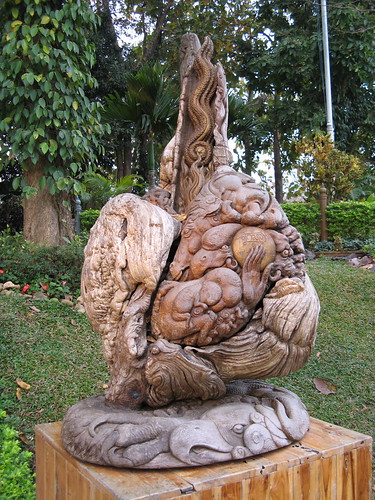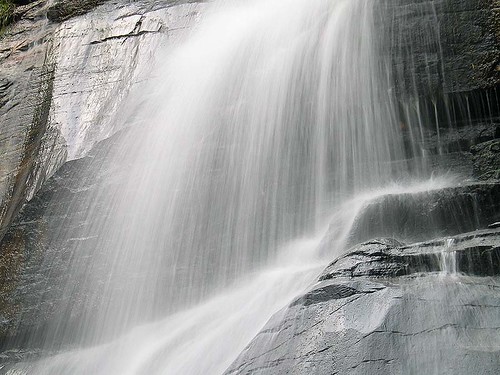 The Park boasts a variety of nationally important plants and wild animals, and its tranquility provides an ideal escape to enjoy untouched wilderness and natural beauty. It covers the areas of Samoeng, Hang Dong, Mae Wang, and San Pha Tong, with an approximate area of 484 km2 (302,500 rai). The geographical features of the park consist of high igneous and limestone mountains. Yod Khun Thian is the highest peak, rising to an altitude of 1,550 m. In the area, there are virgin arid, evergreen pine, and mixed forests. Op Khan is the source of many rivers and gullies flowing into the Mae Wang, Win and Khan Rivers.
The Park boasts a variety of nationally important plants and wild animals, and its tranquility provides an ideal escape to enjoy untouched wilderness and natural beauty. It covers the areas of Samoeng, Hang Dong, Mae Wang, and San Pha Tong, with an approximate area of 484 km2 (302,500 rai). The geographical features of the park consist of high igneous and limestone mountains. Yod Khun Thian is the highest peak, rising to an altitude of 1,550 m. In the area, there are virgin arid, evergreen pine, and mixed forests. Op Khan is the source of many rivers and gullies flowing into the Mae Wang, Win and Khan Rivers.In addition, the pretty and fragant orchid 'Ward Dendrobium' (Dendrobium wardianum Warner) is found only in this area of Thailand. This beautiful orchid blooms in January each year. Its Thai name 'Ueang Manee Tri Rong' means 'three-coloured jewel'. Its cute little petals are mostly white, with purples edging at their tips. The middles are yellow with brown at the center, giving it a unique and beautiful look.
The Park offers many attractions, including rivers, waterfalls, and hillside plains with traditional villages. Wild animals found in the National Park include gorals, Muliacus Muntjak, bears, fishing cats, mouse deer, masked palm civets, wild rabbits, wild boars, monkeys, slow loris, mongooses, porcupines, squirrels, tree shrews, rats, etc.
Op Khan Gorge
Op Khan Gorge is a strange and beautiful natural sightseeeing spot, which is just 450 m from park headquarters, accessible by foot. It originated from the erosion of cliffs on both sides of Mae Khan River. The River flows though 30 metre-high cliffs facing each other.
Activities: camping, hiking nature trails, cave / geological touring.
Huai Ya Si
Huai Ya Si is about 1 km from headquarters. It is a curved section of the Mae Khan River, where the river changes direction. The curve is almost 90 degrees, hence it slows down the river's flow considerably. Both banks of the gully are covered with Ya Si (Leersia hexandra SW), a lush green plant with beautiful blossoms. Huai Ya Sai is a small shallow gully suitable for swimming.
The sightseeing spot, built by the Park, provides breathtaking scenery, a tranquil atmosphere and the soothing sound of the winding Mae Khan River flowing past its rocky banks.
Pha Tub
Pha Toob, a small cliff standing beside a hill, is about 500 metres away from Huay Ya Si. From the base of Pha Toob, there is smooth detritus extending to the Mae Khan River. The everflowing current shapes the cliffs into interesting forms.
Huai Pong
Huai Pong stream is about 2 km from the headquarters, and is suitable for swimming. Visitors can also enjoy wild flowers along the trails.
Mae Tian Waterfall
Mae Tian Waterfall is a single-level waterfall, originating from Mae Tian River. This waterfall is tapped for electricity by a power plant.
Tham Takkatan (Grasshopper Cave)
This large cave of 7,000 m in length contains stalactites, stalagmites. There are also ancient sculpted pictures adorn the cave walls.
Besides these attractions, Op Khan National Park contains Tham Doi Ton, Mae To Hot Springs, as well as other waterfalls for visitors to explore, such as Khun Puai Waterfall, Morakot Waterfall, Mae Mud Waterfall, Khun Win Waterfall, and Mae Wang Waterfall. In addition, the park also provides nature trails for hiking and leisurely walks.
Getting There:
From Chiang Mai, drive along Highway No.121 to Hang Dong for about 15 km, a scenic route hugging an irrigation canal. Then turn right on the Namprae - Op Khan Ro Pho Cho Road for about 10 km. Note that the road is steep and curvy! Visitors will arrive at park headquarters.


























